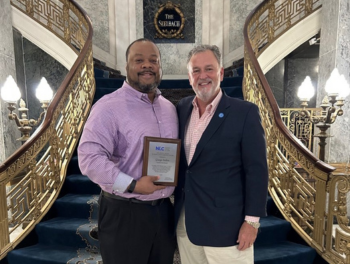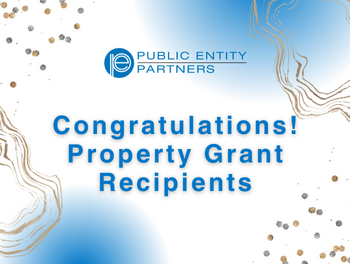PartnersNews - November 2023
In this month's issue:
- Understanding the Impact of a Hard Insurance Market on Your Premiums
- Workers' Compensation Training Nov. 2
- PEP's Executive Vice President Receives National League of Cities Service Award
- PEP Property Conservation Grants Awarded
- Cold Weather Work Environments
Understanding the Impact of a Hard Insurance Market on Your Premiums
In the ever-evolving landscape of insurance, there are periods when the industry undergoes significant shifts that can directly impact policyholders. One of these phases is known as a "hard insurance market." It’s crucial to understand what it means and how it can affect your insurance premiums.
The Hard Insurance Market Explained
The hard property market is characterized by a period of increased scrutiny and stricter underwriting standards by insurers and reinsurers. During these times, obtaining insurance coverage becomes more challenging and the cost of premiums tends to rise significantly. But what exactly causes a hard insurance market to emerge?
Factors Contributing to a Hard Insurance Market
Several factors contribute to the onset of a hard insurance market, and they often combine to create a challenging environment for both insurers and policyholders. These factors include:
- Rising Reinsurance and Construction Costs: Insurance companies rely on reinsurance to manage their risks. When reinsurance costs increase due to factors like more significant claims or market fluctuations, insurers may pass these expenses onto policyholders.
- Valuation Adjustments: Changes in the valuation of insured properties, such as an increase in property values, can impact the amount of coverage needed, leading to higher premiums.
- Increased Claims Costs: A surge in insurance claims, whether due to natural disasters or other factors, can strain an insurer's resources, causing them to raise premiums to maintain profitability.
- Natural Disasters and Catastrophic Events: Events like hurricanes, wildfires or earthquakes can result in substantial insurance losses, prompting insurers to reevaluate their risk exposures and adjust premiums accordingly.
- Inflation: The erosion of the purchasing power of money through inflation can affect the cost of materials and labor, which in turn affects the cost of rebuilding or repairing damaged properties, leading to higher premiums.
How does this affect you?
The consequences for policyholders during a hard insurance market include:
- Higher Premiums: One of the most noticeable effects is an increase in insurance premiums. Policyholders can expect to pay more for their coverage, which can strain personal or business budgets.
- Limited Coverage Options: As insurers become more cautious, they may be less willing to provide coverage for high-risk properties or businesses, leaving policyholders with fewer options.
- Increased Deductibles: Insurers may also respond to market pressures by increasing deductibles, shifting more of the financial burden onto policyholders in the event of a claim.
What we’re doing to support our members
As a nonprofit organization, Public Entity Partners serves as the administrator of a voluntary, self-insured, risk-sharing partnership. In addition to providing property coverage, we assist members in their efforts to safeguard public resources through various risk management programs and services.
We accomplish this through:
- Appraisals: What are they and why are they important?
PEP’s Property Valuation Program provides each member with a professional valuation on locations assessed at $75,000 or more. This program helps ensure that our members’ properties are properly valued and adequately insured, and allows us to provide true replacement costs and actual cash value (ATV) coverages without a coinsurance clause or penalty.
- Property Conservation Loss Control Surveys: What are they and what are they designed to do?
PEP provides a loss control survey for each member with property coverage to identify possible exposures.
These surveys enable PEP to:
- Recommend best practices to prevent loss or damage to your property;
- Minimize the occurrence of property claims;
- Ensure we have a complete list of every property owned by the entity.
A property loss control survey assists the member in the development or maintenance of the member’s current property risk management program. The frequency of a property loss control survey is determined by the total insured property value of the member.
- Property Conservation Grant: What is this and what is it designed to do?
The Property Conservation Grant was created to encourage our members to prioritize their property conservation risk management program, and help offset the cost of maintaining the facilities they own and operate by minimizing loss.
- Property Conservation Loss Control Training:
The Loss Control Property Consultants can provide each member with a training program designed to identify the common causes of property claims. The training includes best practices of financial controls, cyber risk, housekeeping, lightning attenuation, fire extinguishers, fire suppression and storage of chemicals. PEP is currently in the process of creating additional training programs for our members.
- Assistance With Renewals:
Our member services team is available to assist with your renewal applications to review coverages, navigate deductibles, and review the differences between replacement cost and actual cash value so you can decide how to best insure your property.
What can members do to offset costs and prevent losses?
We understand that navigating a hard insurance market can be challenging for our members. However, we want to assure you that we are your partner in risk mitigation, and we are committed to helping you manage the complexities of this challenging landscape.
There are steps members can take to help control costs and mitigate losses, such as developing a basic understanding of:
- Your property coverage policy;
- Available risk retention and financing alternatives;
- Property conservation best practices;
- The elements of a property conservation risk management program.
Over the coming months, Public Entity Partners will cover additional areas of property conservation best practices in a series of newsletter articles aimed at helping our members. Should you have any questions in the meantime, please reach out to your Member Services Representative for assistance.
Workers’ Compensation Training Nov. 2
The final installment of the Public Entity Partners and MTAS (Municipal Technical Advisory Service) risk management series will be held on Nov. 2. This session will cover “Workers’ Compensation: Protecting Your Employees and Your Operations.”
Led by Sarah Curtis, PEP’s Loss Control Training Consultant, this session will provide you with steps to properly manage your workers’ compensation claims, and help ensure the best possible outcome for your injured employee and organization. Additional resources will be shared with participants to assist in navigating the workers’ compensation claims process.
All organizations will have a workers’ compensation claim at some point. This training will educate participants about the most common risk exposures faced by public entities and how they can utilize best practices to minimize risk.
For more information about this training opportunity, please visit https://www.mtas.tennessee.edu/training-calendar.
For registration questions, please contact mtas_training@tennessee.edu
PEP’s Executive Vice President Receives National League of Cities Service Award
The National League of Cities (NLC) bestows its John G. Stutz Award on people who have served 25 years or more on the staff of a state municipal league, state league risk pool, or at NLC. The award is named in honor of John Stutz, who convened representatives of 10 state municipal leagues for the first meeting of what was to become the American Municipal Association and, subsequently, the NLC.
Public Entity Partners’ Executive Vice President George Dalton received the honor this year. Since 1998, Dalton has served in several positions at PEP. He started his career as a Loss Control Consultant, working in the field with our membership, assisting them to ensure they were implementing best practices for risk management, and recommending modifications to mitigate losses. He was later promoted to Assistant Director of Loss Control, then Director of this department. In 2020, he was named Executive Vice President, where he manages several departments that serve PEP’s membership directly.
“It is an honor to have served Public Entity Partners and Tennessee public entities for the past 25 years,” Dalton said. “It is a pleasure to work with the team at PEP and, ultimately, with municipalities across the state. I look forward to several more years of service.”
PEP congratulates George Dalton and the excellence he represents every day.
PEP PROPERTY CONSERVATION GRANTS AWARDED
While property coverage can protect your organization in the event of a loss, an effective risk management program will help to reduce the frequency and severity of claims. Public Entity Partners’ Property Conservation Grant provides funding for the purchase of loss prevention and control items.
This year, PE Partners is proud to have awarded 65 Property Conservation Grants, totaling $225,000 in funding. Some of the approved purchases include security lighting and cameras, fencing, lightening attenuation, fire suppression items, security network protection, bollards, and security systems to prevent vandalism and theft.
For more information on the Property Conservation Grant Program, please contact Tahtia Mitchell at TMitchell@PEpartners.org.
COLD WEATHER WORK ENVIRONMENTS
Everyone knows how uncomfortable cold weather can be — and if you must work in it, it can be even worse.
Many of Public Entity Partners’ members have employees who cannot avoid working in cold conditions. Some of these include construction, police, fire, emergency responders, trucking, road repair, utility repair and many more.
The biggest health risk of being overexposed to cold is getting hypothermia — or a drop in the body’s temperature below 95 degrees. This usually occurs in temperatures between 30 and 50 degrees, but it can also happen in temperatures as high as 65 degrees. Other risks include frostbite, dehydration, chilblains, and indirect reactions due to pre-existing conditions, such as arthritis or asthma.
Employers need to ensure their employees take appropriate precautions to avoid workplace injuries during cold conditions. Cold-weather worker protection includes:
- Using insulated tools so skin does not come into contact with cold metals;
- Wearing hats, hoods and masks to help retain body heat since 40% of heat loss occurs through the head;
- Dressing in layers and making sure the outer layer is wind- and water-resistant;
- Protecting hands by wearing gloves (workers who need more hand flexibility can consider fingerless gloves when necessary);
- Wearing waterproof insulated boots over wool socks;
- Having a change of clothing on hand in case clothing gets wet while working or PPE becomes damaged.
Working in cold conditions presents a variety of hazards, including wind and dampness, that require numerous protection measures. If you don’t have a plan for cold stress prevention, now is the time to put one together. EHS Hero™ has a template to assist you in creating this plan.
To obtain access to the EHS Hero safety plan resources, please contact Heather Sturtz at HSturtz@PEpartners.org.




